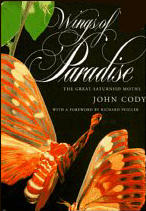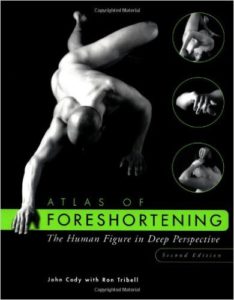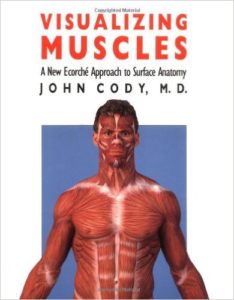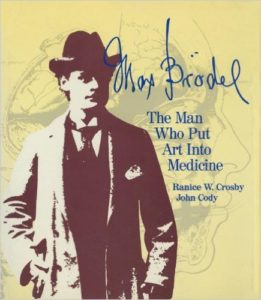Wings of Paradise
The Great Saturniid Moths, University of North Carolina Press, 1996

The lovely saturniid moth, the most majestic of insects, also has one of the most poignant and romantic life stories: born without a mouth, a stomach, or any defensive mechanism beyond camouflage, each moth lives just a few days—long enough only to mate—and then it dies. Because the moths are nocturnal, and some species are endangered, many people will glimpse these beautiful creatures only through the paintings of John Cody, who has been called ‘the Audubon of Moths.’
Cody has spent a lifetime studying and painting the Great Saturniids, also known as silkmoths. In pursuit of his avocation, Cody travels frequently to distant and exotic locales to collect cocoons and learn about the moths’ native environments. He then brings specimens home; as the moths emerge from their cocoons, Cody has only a brief time to capture and record their distinctive coloration before they die.
Seventy-two of Cody’s paintings of saturniids are included here, accompanied by his commentary on the moths’ life cycles, habitats, and geographical range and on the circumstances of his finding and painting each moth. A foreword by Richard S. Peigler, curator of entomology and saturniid specialist at the Denver Museum of Natural History, provides scientific background on the Saturniidae.
Atlas of Foreshortening
The Human Figure in Deep Perspective (Second Edition), Wiley & Sons, 2002
A unique visual encyclopedia for artists and illustrators
Like its acclaimed predecessor, the Second Edition of this outstanding photographic reference offers illustrators, fine artists, and animators immediate access to the human form in deep perspective, that is, foreshortened. With all-new photographs, the Atlas of Foreshortening features:
* Over 530 high-quality photographs
* Both male and female nudes
* Poses with slight, moderate, and marked foreshortening
* Detail shots and full-body photographs
* Many poses shot from multiple angles
Visualizing Muscles
A New Ecorché Approach to Surface Anatomy, University Press of Kansas, 1991
 As the human body moves, muscles contract and relax, creating subtle changes in body contours and shifting patterns of light and shadow on the skin’s surface. Visualizing exactly what happens beneath the skin to cause these changes on the surface is an essential skill for artists, physicians, physical therapists, and body builders-for anyone who needs to understand the body in motion.
As the human body moves, muscles contract and relax, creating subtle changes in body contours and shifting patterns of light and shadow on the skin’s surface. Visualizing exactly what happens beneath the skin to cause these changes on the surface is an essential skill for artists, physicians, physical therapists, and body builders-for anyone who needs to understand the body in motion.
But how do you teach this skill?
Why not paint a live model to look as though his skin had been stripped off and then photograph him in multiple poses? From that idea comes Visualizing Muscles, an innovative aid to drawing, sculpting, and learning surface anatomy.
More than one hundred static and active poses are included in Visualizing Muscles. Paired photographs one painted and labelled, one not show how the simulated muscles produce the subtle lights and darks, hills and valleys, on the model’s unpainted skin. Captions highlight the muscles called into play by a given pose.
Dr. Cody, who experimented with techniques for two years, pioneers the use of a model on whose skin muscles, tendons, and fascial sheaths are painted with scientific accuracy. Because of the elasticity of the skin and paint, the painted musculature expands and contracts along with the underlying muscles. Thus Cody’s technique enables students of anatomy to visualize the muscles beneath the skin and the changes brought about by movement.
Max Brödel
The Man Who Put Art Into Medicine, Springer-Verlag, 1991

This book, with its spectacular illustrations, tells the interesting story of the life of Max Broedel, the pioneering medical illustrator and founder of the Department of Art as Applied to Medicine at The Johns Hopkins University in Baltimore.
After Great Pain
The Inner Life of Emily Dickinson, The Belknap Press of Harvard University Press, 1971

In this unusual biography, the product of seven year’s intensive study, John Cody, a practicing psychiatrist, offers a fresh and persuasive interpretation of what made Emily Dickinson the person and poet she came to be. By approaching her poems and letters-a rich though cryptic record of her feelings and fantasies-as psychological documents, he is able to trace the undercurrents that permeate her poetry and to integrate the external signs of psychic disturbance, such as her reclusion, into a total view of her emotional development. Emily Dickinson, according to Dr. Cody, experienced her mother as inaccessible, ineffectual, and self-abnegating, and thus suffered a twofold deprivation: an unappeasable longing for maternal affection and the absence of an adequate feminine model on which to pattern her own development as a woman.
Nominated for 1972 National Book Award – 3/27/1972 NYT Article